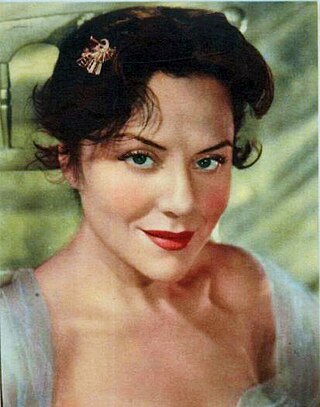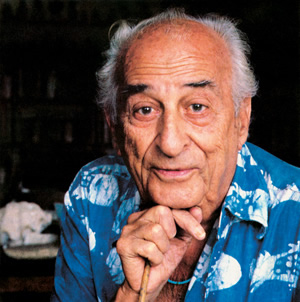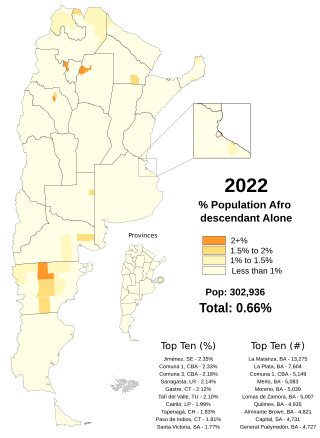Related Research Articles

Candombe is a style of music and dance that originated in Uruguay among the descendants of liberated African slaves. In 2009, the United Nations Educational, Scientific and Cultural Organization (UNESCO) inscribed candombe in its Representative List of the Intangible Cultural Heritage of Humanity.
The Conservatorio Nacional Superior de Música is the national music conservatory for Argentina and it is located in Buenos Aires.

Amelia Bence was an Argentine film actress and one of the divas of the Golden Age of Argentine Cinema (1940–1960).

Héctor Julio Páride Bernabó was an Argentine-Brazilian artist, researcher, writer, historian and journalist. His nickname and artistic name, Carybé, a type of piranha, comes from his time in the scouts. He died of heart failure after the meeting of a candomblé community's lay board of directors, the Cruz Santa Opô Afonjá Society, of which he was a member.

Afro-Argentines, also known as Black Argentines, are Argentines who have predominantly or total Sub-Saharan African ancestry, these stand out for having dark skin. The Afro-Argentine population is the result of people being brought over during the transatlantic slave trade during the centuries of Spanish domination in the region and immigration.
The Morenada is an Andean folk dance whose origins are still under debate. This dance is practiced mainly in Bolivia as well as in Peru and in recent years with Bolivian immigration in Chile, Argentina and other countries.
Nicole Nau is a German dancer of Tango Argentino and Argentine folklore living in Argentina and Germany.

Luis Pereyra is a dancer and choreographer of Tango Argentino and Argentine folk dances.

María Ruanova was an Argentine dancer, choreographer, teacher and ballet master, known for her performances at the Teatro Colón and internationally. She is considered the first Argentina-grown ballet dancer to gain international fame.

Ana Itelman was a Chilean-born dancer and choreographer, who spent most of her career in Argentina and the United States. Serving as a professor at Bard College and then director of the school of dance, she toured internationally between 1957 and 1969. In 1970, she returned to Argentina and established a contemporary dance theater. She was honored with the Konex Award for choreography in 1989.

LGBT in Argentina refers to the diversity of practices, militancies and cultural assessments on sexual diversity that were historically deployed in the territory that is currently the Argentine Republic. It is particularly difficult to find information on the incidence of homosexuality in societies from Hispanic America as a result of the anti-homosexual taboo derived from Christian morality, so most of the historical sources of its existence are found in acts of repression and punishment. One of the main conflicts encountered by LGBT history researchers is the use of modern concepts that were non-existent to people from the past, such as "homosexual", "transgender" and "travesti", falling into an anachronism. Non-heterosexuality was historically characterized as a public enemy: when power was exercised by the Catholic Church, it was regarded as a sin; during the late 19th and early 20th centuries, when it was in the hands of positivist thought, it was viewed as a disease; and later, with the advent of civil society, it became a crime.
Sandra Chagas, sometimes , is an Afro-Diasporica dancer negra Candombera and activist.
Liliana Maresca was an Argentine artist. Her works cover a variety of styles including sculpture, painting, graphic montages art objects and installations. She was a prominent artist in the period following the dictatorship of the National Reorganization Process. She was a key figure who participated in the artistic scene since the early 80's, starring the enthusiastic young bohemian that detonated Buenos Aires from the early years of democracy rapidly becoming an inflection figure. Her works included objects, installations, performances, interventions in public and semipublic places, and the photographic performances. Maresca died of AIDS in 1994, just a few days after the opening of her retrospective at the Centro Cultural Recoleta in Buenos Aires.

Eugenia Belín Sarmiento was an Argentinean painter and author. Her works were featured in various international shows, among them the first Exposición Anual de Pintura, Dibujo y Escultura for artists of South America in 1893. Critical response to her works has often focused attention on her portraits of her grandfather, Domingo Faustino Sarmiento, who was president of Argentina from 1868 to 1874. Eugenia completed many other works as well, including miniatures as well as full size portraits, paintings of flowers, birds, and still lives, and sculptures.

Laura Malosetti Costa is a Uruguayan-born Argentine social and cultural anthropologist, researcher, art historian, and essayist. She is also a curator of art exhibitions and the author of several books on Latin American art. She was recognized with the Konex Award in 2006 and 2016.

Dora Beatriz Barrancos is an Argentine researcher, sociologist, historian, feminist, and politician.
Silvia Rivas is an Argentine visual artist known for her multi-channel video installations. In Latin America she is considered a precursor in the area of expanded video. Her work is characterized by the crossing of materialities and technologies in which she uses both electronic devices and ancestral techniques. Her production is organized in thematic series of video installations, drawings, photographs or objects. Interested in revealing the metaphorical power of different materialities, she uses the electronic medium and the moving image to record stillness, the imminent and the subjective perception of time.

Rosa Faccaro was an Argentine art critic, painter and university teacher who specialised in contemporary, Pre-Columbian and textile art. She received several awards for her work, was curator of multiple art exhibitions and was a jury member of many international and national awards. Faccaro collaborated to the artistic section of the newspaper Clarín from 1979 to 2000.
Susana Zimmermann (1932-2021) was an Argentine dancer and choreographer. She was a pioneering figure in contemporary dance in Argentina and had choreographed at least sixty performances staged in different countries. Zimmermann was also an educator and is noted for developing a methodology for dance instruction.
Stella Manuela Juliana Calloni Leguizamón is an Argentine journalist and writer specializing in international politics, whose investigative work focuses on Latin American military dictatorships and related political processes. Her books Los años del lobo: la Operación Cóndor (1999) and Operación Cóndor, pacto criminal (2006) gather parts of her research into the campaign known as Operation Condor.
References
Citations
- 1 2 3 4 5 6 7 8 Fernández Bravo 2016.
- 1 2 3 4 Más 2016.
- 1 2 3 4 Florencia 2013, p. 3.
- 1 2 Montenegro 2017.
- ↑ Ministry of Education 2006.
- ↑ Infante 2010, p. 86.
- ↑ Plaza 2006.
Bibliography
- Fernández Bravo, Nicolás (2016). "Soares, Isa (1953– ), Afro-Brazilian dancer, dance instructor, and activist". In Knight, Franklin W.; Gates Jr., Henry Louis (eds.). Dictionary of Caribbean and Afro–Latin American Biography. Oxford, England: Oxford University Press. ISBN 978-0-199-93580-2. – via Oxford University Press's Reference Online (subscription required)
- Florencia, Piña (2013). Expresiones artísticas afro y redefiniciones de la memoria social en la Ciudad de Buenos Aires: La danza de Orixás [Afro-artistic expressions and redefinitions of the social memory of the City of Buenos Aires: The Dance of Orixás](PDF). VII Jornadas Santiago Wallace de Investigación en Antropología Social (in Spanish). Buenos Aires, Argentina: Instituto de Ciencias Antropológicas, Universidad de Buenos Aires. Archived from the original (PDF) on 6 March 2018. Retrieved 6 March 2018.
- Infante, Javier Alejandro (2010). El Juego como uno de los métodos de la transmisión oral en el aprendizaje de las culturas negro africanas [Play as one of the methods of oral transmission in the study of black African cultures] (Licenciatura en Artes Visuales) (in Spanish). Buenos Aires, Argentina: Instituto Universitario Nacional del Arte . Retrieved 6 March 2018.
- Más, Toni (September 2016). "Isa: Un Mundo en 16 Instancias" [Isa: One World 16 Moments]. Balletin Dance (in Spanish). 23 (257). Buenos Aires, Argentina: Editorial Balletin Dance. ISSN 1850-6275. Archived from the original on 6 March 2018. Retrieved 6 March 2018.
- Montenegro, Alfredo (30 May 2017). "Las raíces negadas (parte IV): La resistencia en danza" [Roots denied (part IV): The resistance in dance] (in Spanish). Rosario, Argentina: Redacción Rosario. Archived from the original on 29 August 2017. Retrieved 6 March 2018.
- Plaza, Gabriel (1 December 2006). "El retumbar de la cultura afro" [The rumble of African culture] (in Spanish). Buenos Aires, Argentina: La Nación. Archived from the original on 6 March 2018. Retrieved 6 March 2018.
- "4° Escuela de Verano de Arte y Educación" [4th Summer School of Art and Education]. Education Argentina (in Spanish). Buenos Aires, Argentina: Ministry of Education. 21 February 2006. Archived from the original on 5 June 2009. Retrieved 6 March 2018.